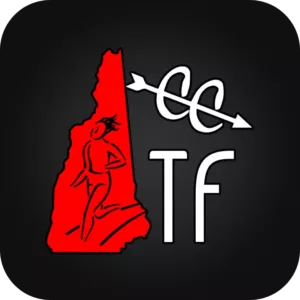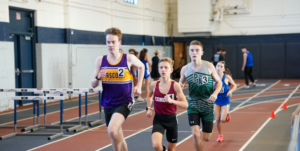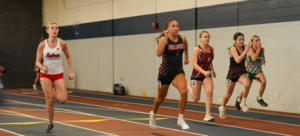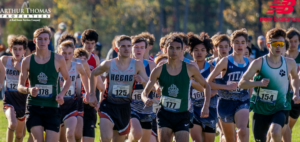LIMINALITY
I have two younger brothers. Like me, they both ran cross-country at Concord High School. Over Labor Day weekend all three of us were in Vermont to watch our youngest brother compete in the Green Mountain Stage Race. The GMSR is a four day cycling race on the most challenging roads in the north east.
 Stage Three of the race was the Queen Stage. On that Sunday, the temperature rose rapidly as the racing began. The riders faced a course totaling over one hundred miles. They would have to race up and down the gap roads of Green Mountains for over four hours as they climbed a total of ten thousand feet by the day’s end. The finish line of that day’s race seemed to be designed as a cruel summary of the course: a final five hundred meters of road at a fifteen to twenty percent gradient all the way to the line.
Stage Three of the race was the Queen Stage. On that Sunday, the temperature rose rapidly as the racing began. The riders faced a course totaling over one hundred miles. They would have to race up and down the gap roads of Green Mountains for over four hours as they climbed a total of ten thousand feet by the day’s end. The finish line of that day’s race seemed to be designed as a cruel summary of the course: a final five hundred meters of road at a fifteen to twenty percent gradient all the way to the line.
It was on that final slope that I watched the finish of Sunday’s racing. Riders came in small groups, sometimes in pairs, but more often than not they came in alone. Each man and woman was absorbed in their own rhythm, traveling as part of a slow motion parade. Some squinted behind their sunglasses as the salt of their sweat stung their eyes. Others pushed through the final phase of distress with mouths open in a silent howl. They looked straight through the spectators on the side of the road; unwilling to remind themselves that the road was not done going up. One rider came past chanting, “Bacon and Beans! Bacon and Beans!”
I watched as another rider begin to wobble on his bike and then stop. He scrambled out of the saddle. With the bike’s frame gripped tightly in his hands he leaned forward – pushing the bike out and away from him, his eyes screwed shut. Then he started screaming. It was a sound of agony, but more so of anger and frustration. His muscles had failed with only a few hundred meters remaining. Over four hours of racing and with less than a minute left, his legs had given out.
For the spectators it was nothing out of the ordinary. Everybody kept cheering and clapping for their friends and teammates as we all watched them work their way up the last hill on the course. In endurance sports, moments of physical collapse are normal; so common that people are not phased by cramping or shouting or twisted grimaces anymore. Even for the racers, who are trapped in those short lived moments of misery and self-doubt, it is just one small piece of the broader scenery of racing.
After a minute’s pause to work out the cramping in his legs, the rider remounted his bike and pedaled across the finish line. Ten minutes later I saw him laughing with some of the other riders as he mimed his moment of distress.
The finish line on that Sunday, like all finish-lines I have seen, was a truly happy place. The scenes that played out on the other side of the line on the road were complete at odds with the scenes playing out on last slope, mere meters away. In fact, the only time I have seen angry people at the finish line has been when they wished they had suffered more. In between the nerves of the start and the joy of the finish is the suffering, pain, misery, grind, the simple awfulness of what we experience. From Professor Danny Danforth’s Anthropology course I learned that experiences like these involve a liminal state.
The liminal state is an in-between state. It is when we are in the process of becoming something new, so we aren’t what we were when we started, but we also haven’t finished our transformation. These liminal states are usually characterized by an altered state of being, you are trapped on a threshold, not yet in, but no longer out.
A race is a moment spent in the threshold. A race takes place in a space between who we were and who we want to become. In that space we experience genuine physical and psychological discomfort. People don’t run a sub-four minute mile because they want to experience pain. They do it because they want to cross the finish line and feel the jubilation that comes after accomplishing their goal.
But if a four minute mile were easy, then we would be indifferent to the achievement. It wouldn’t even be considered an achievement. The pain that makes the sport hard and that makes us doubt our ability to endure is also what pulls us back. Our pain is liminality – we do not know what we are becoming, only that something is going to be different when we cross the finish line. We know that the greater the suffering, the greater we will change ourselves.
Anthropologists study rituals and rites of passage and seek to uncover moments of liminality. They want to describe the ways in which liminal experiences make people different. But the greatest pain philosopher is an Australian running coach and guru who came to international prominence in the 1950s and 1960s.
Percy Cerutty (1890-1975) is best remembered for coaching Herb Elliot, the 1960 Olympic 1500m champion and world record holder in the one mile and 1500m. Elliot was never beaten in the 1500 or the mile during his career. Cerutty encouraged the athletes to focus on the challenge of the sport. His approach was totally immersive, running was to be lived fully, not done on the side of other parts of life. He set the example himself, training alongside runners far younger and faster than he was by that point in his life.
 He was inspired by the example of the Spartans, warriors of Ancient Greece whose mothers admonished them to come home with their shields or on them when returning from battle. He also admired the Stoic philosophers and their belief that emotions could be mastered by self control and will power. Melding the two together into an awkward phrase, he began to urge his followers to become “Stotans.”
He was inspired by the example of the Spartans, warriors of Ancient Greece whose mothers admonished them to come home with their shields or on them when returning from battle. He also admired the Stoic philosophers and their belief that emotions could be mastered by self control and will power. Melding the two together into an awkward phrase, he began to urge his followers to become “Stotans.”
From this mashing of Greek history he began to encourage runners to move towards the pain of running as much as possible. Training was designed to elicit as much pain as possible so that the athletes could attempt to confront it and master it. He told his disciples that, “Pain is the purifier. Love pain. Embrace pain.” For Herb Elliot, and others, this worked.
One story goes that, in Elliot’s ultimate moment, enroute to Olympic victory, Percy Cerutty fought his way through the crowd to the side of the track so he could yell encouragement to Elliot, “Faster! It is only pain!” Elliot won that race by 20 meters.
“Spirit,” Elliot later said, “as much as or more than physical conditioning, had to be stored up before the race.” Perhaps this spiritual energy, this carefully tended capacity to push against adversity, is what allowed Elliot to become stotanistic and remain unbeaten over the 1500m or the One Mile.
The mind can play tricks on us when we race. I have gone to the starting line when I couldn’t walk properly. Then, when the gun fires something fundamental changes inside of me, the sprained ankle or strained calf is no longer limiting my ability to perform and I fly through the race. But in the moment I cross the finish line the injury seems to return and I am once again reduced to limping, wondering what just happened. My youngest brother raced at NCAA DIII Nationals his senior year with a sore leg. The next week he learned the soreness was because the bone had snapped, he shouldn’t have been able to run at all.
I do not think that in those moments we embraced the pain of our injuries so fully that we purged it’s existence from our minds. I also do not recommend that any runner ever ignore an injury. But it is true that our conscious perception of what our body experiences can change when we enter into that time of liminality. Rushing to embrace pain may have been key for Elliot. But focusing on pain as the purifier was a little too extreme for another great Australian Runner. John Landy, who battled with Roger Bannister to be the first man under four minutes, trained with Cerutty for a time before finally moving on after growing tired of Cerutty’s methods.
Landy did not break four minutes first. He declared that it could be done, but not by him. Then Bannister broke through and Landy, despite his self-doubt, performed the feat himself a short time later. This, naturally setup one of athletic’s many “Dual of the Century” moments. In the resulting showdown at the Commonwealth Games in 1954, it was Landy who came up just shy of ultimate success once again. Bannister, who seemed full of suffering and misery prevailed. Landy did go on to take home an Olympic medal, but for him it was a bronze in 1956. At the next Olympics, Landy’s would be outshined by Cerutty’s greatest pupil when Elliot claimed gold.
Runners, cyclist, nordic skiers, swimmers, all endurance athletes have a strange relationship with pain. The background hum of discomfort, elevated sense of exertion is omnipresent in training. It is amazing what endurance athletes will tolerate in pursuit of improvement. Runners will sweat so much in training that it looks like they just climbed out of a swimming pool and think nothing of it. But if they sweat an ounce during the school day, the complaints will be long and loud in the locker room. When we lace up our trainers, flats, or spikes and ask our body to perform, a switch is flipped. We are no longer normal, we have moved into the liminal threshold.
I have runners who in what must be abject misery on a training run or workout, or even after a race, excitedly tell me how good they felt when I had just seen them breathing so hard that their eyes were starting to rolling up into the back of their head.
I understand why we love this.
We love challenge, we love adversity. We love to do battle with our unconscious mind. We want to show that we are in control, that we can, through desire and will, make our aspirations into reality. The greater the barriers to achieving that goal, the more inspired we become to perform. But, at the end of a race, I cannot even think, “Faster! It is only pain!” because my brain is already focused on yelling at me to stop or at least slow down.
There is a distinction between sufferings. In that liminal space between starting line and finishing tape it is possible to have two very different experiences. Sometimes you hurt and feel like garbage, dragging reluctant and heavy legs around a race course. Sometimes you hurt just as much but you feel better, fresher, more alive than at any other moment in your life. The urge to go faster and faster takes over and you no longer even feel the ground beneath you feet. These are the moments, no matter how ragged our breathing, that keep us coming back for more. Suffering is inevitable. At some point in a race we will have to push through a period of discomfort. In those moments, it helps to remember that everybody else around us likely is working just as hard and maybe harder.
Research has been done on how pain limits performance. In one study, researchers used injections on a group of cyclists to turn their pain receptors off. They were then asked to ride a max effort time trial. They set of at a scorching pace, and at the end the test subjects quite literally could not walk; they had completely maxed out their muscles. A second group of cyclists rode the same time trial without any injections. They did not max out their muscles, they walked away unassisted. Interestingly, they were also faster than the cyclists who had their pain on mute. Pain is really about limitations, not about choice. Our pain helps us bring out the best in ourselves; it determines what we are actually able to do.
TRIBE too has to navigate the zone of pain. We still relish challenge and adversity; it is what makes what we do worthwhile. We believe that only through great difficulty can we reach our satori. The physical test of the race makes our enlightenment possible, our transcendence inevitable. We believe that with each training run, specific session, and race we have a chance to become one with our body. Listen to the pain, it is our body talking with us, your unconscious mind is trying to start a conversation with you. Don’t try to fight it or ignore it. Definitely do not fear it.
We are like surfers riding the ultimate monster wave. Sometimes we do lose our balance and tumble, wipe outs are inevitable. But sometimes we find a perfect moment of zen when we are completely in balance with the environment of the race. When we do that, we can maintain our balance and poise all the way to the finish line. But what about those moments when we come up short of our race goal? Was it Elliot’s spiritual energy, his capacity to push against adversity that allowed him to claim victory while Landy finished just shy? Did Landy lack the understanding of his innermost self?
There is always a temptation to dismiss the losing runners in any race as not being able to hurt enough. Certainly Landy does look a little more serene next to the rictus howl on Bannister’s face at the finish line. There is a lesser known fact about their showdown. Before the race, Landy had stepped on a flash bulb that had been dropped by a photographer. The glass had sliced open the bottom of his foot and he needed stitches to keep the wound closed so that he could race. Landy preferred to say nothing. Against Landy’s wishes a doctor shared this information with the press. Landy, upset because he feared that knowledge of that injury would taint the public’s perception of the race, insisted the injury had nothing do with the outcome of the race.
Maybe when the gun went off, Landy had the same experience that I have had before – the pain simply vanished. Maybe he embraced the pain and it purified him. Or maybe Landy simply found his balance and rode his liminal wave to the finish line
The great champions do not always win, but they always overcome adversity.
-Coach Bling
Watch Bannister v. Landy in the Miracle Mile in 1954
Ryan Devine
 Pain is a signal. Our nerves send messages to your brain: stop doing this; avoid that, danger ahead! But maybe there is more to pain – it must be more than a warning. Why else would we willingly put ourselves through such an immense amount of suffering race after race? I think we love pain. As runners, we all have our own reasons to love pain, otherwise we wouldn’t be on the starting line. I love pain because it brings people together, and it does so better than any team bonding activity.
Pain is a signal. Our nerves send messages to your brain: stop doing this; avoid that, danger ahead! But maybe there is more to pain – it must be more than a warning. Why else would we willingly put ourselves through such an immense amount of suffering race after race? I think we love pain. As runners, we all have our own reasons to love pain, otherwise we wouldn’t be on the starting line. I love pain because it brings people together, and it does so better than any team bonding activity.
At the start of my freshman year at Concord I had three close friends and my family.. Today, thanks to pain, I still have three close friends, but now I have two families; my biological family is still there, but now there is also TRIBE. I spend more than four hundred hours a year with TRIBE training, racing, traveling, and ultimately suffering. Of these experiences suffering has caused us to grow into something greater than a group of friends. It made us family.
Although the process of becoming a family through our shared pain there is one moment that cemented this transition. On a freezing winter morning, music turned up full blast, we pulled into Bling’s driveway. All a little nervous, we parked and gathered inside. We were going to test ourselves over one of our winter training loops. If we could run the course we’d been using in training for months in under two hours, then we knew we would be on track for the future success we were all dreaming of.
This was our “Breaking Two” project, just without the extravagance of Nike. That day, as our “Breaking Two” attempt got underway, there was an unspoken understanding that today was the day. The miles clicked by easily at first. As time past we began to spread apart as we each found our own rhythm. The aching feeling of emptiness overwhelmed my legs and eventually reached my mind. Part way through the course, we made our ritual stop for tea and my spirits were boosted when I found I wasn’t alone in my misery. Everyone complained of pain and tiredness, but all insisted on continuing to push towards our goal.
So we kept pushing forward. The last few miles I was running alone. The overwhelming pain in my legs grew, each step forward felt like another step through hell with my legs burning more and more. Turning the last corner I felt like I was staggering. I made my last push towards the top of the final hill I was completely drained. At the finish I saw my best friends, TRIBE, standing at the end of the driveway. They cheered for me, even as they shivered from the cold while their sweat froze.
In this moment things changed in a big way. We weren’t friends anymore. We were a family – we were TRIBE. Finally done, and in less than two hours, I lay down on the cold pavement and smiled enjoying the moment. TRIBE pulled me to my feet. Shuffling like old men on our battered legs, we headed towards the kitchen and stacks of pancakes, laughing as we talked about the suffering we all shared.
Our misery binds us together. Our misery makes us family. We are only possible because of our pain.
David Cook
 I joke around with my friends outside of running all the time about doing dumb things that might end in misery for me. I always have been like this. Whether it eating very bad things, jumping off of things that should not be jumped off of, or even holding my breath a lot longer than I should at the bottom of the lake. I have always pushed a little farther than I should.
I joke around with my friends outside of running all the time about doing dumb things that might end in misery for me. I always have been like this. Whether it eating very bad things, jumping off of things that should not be jumped off of, or even holding my breath a lot longer than I should at the bottom of the lake. I have always pushed a little farther than I should.
My mother hated that I did this, but when I was little I needed to prove to my friends, and most importantly, to my older brothers, that I could do “it.” The reason why I was able to do all of these things is because of my mantra of truth. Coach Bling might not admit it, but he hates my mantra. If I say, “Mental Toughness” enough times I know, it, whatever “it” is won’t hurt. This works for me a lot better than it should.
Here’s an example. Right now I have a serious problem with my pancreas due to the tsunami of soda I drank during the first few years of high school. Even though I have been to the Emergency Room three times for my stomach problems, I don’t let it bother me. My pancreas pain could have been the cause of days of missed training this summer, but of course did not. The reason for this is mental toughness.
Pain is not real – never has been and never will be. Nobody has ever experienced pain, they only think they experience pain. You know that time when you hit your hip on the kitchen table and it really hurt? You perceive “pain” in that moment but five minutes later you feel fine again. Why is that? It is because the human body is capable of much more than we think. Pushing limits, exceeding boundaries, going further; it’s all possible once you realize pain is not real.
The only reason the human body has set limits for itself is because of the perception of “pain” that society has taught us. I remind myself of that every time I step on the line for a race. Sometimes I am nowhere near the ability level of my competitors as a result of genetics or their own hard training. But I can beat them because I know pain is not real. I have put in a considerable amount training throughout my running career to get where I am now. But I would not say that I am successful in running because of training. I think it all comes down to my perception of pain.
Our team as a whole manages pain much better than other people might guess. I do not believe in any of the pain that I experience. Pain doesn’t limit us, we limit ourselves. It is cliche to say that whatever doesn’t kill you makes you stronger.
But, to be honest, I believe it.
Eli Boesch Dining
 Pain and suffering, some may forever tie these two words together. The truth is that doesn’t have to be the case. Every runner experiences pain. However, some runners have learned to master their pain. For those that have mastered pain, suffering is no longer inevitable.
Pain and suffering, some may forever tie these two words together. The truth is that doesn’t have to be the case. Every runner experiences pain. However, some runners have learned to master their pain. For those that have mastered pain, suffering is no longer inevitable.
There is a phrase, attributed by some to M. Kathleen Casey, “Pain is inevitable. Suffering is optional.” I have no idea who M. Kathleen Casey is, or what experience prompted this observation, but this resonated with me. You are going to experience pain. That is not a likelihood, it is an absolute fact. So what separates the crème de la crème is how they deal with that pain. Don’t give into the pain. Win the race and then you can rest.
I have experienced many hard races in my career. In those races, there has been a lot of pain and a fair amount of suffering. I am very good at pushing myself to my limits. In all of my race photos, I have a grimace of pain on my face as if I’m running over hot coals. Those twisted faces are there because I am utilizing every last drop of energy in my body. I simply cannot relate to having something left in the tank. If I didn’t have as much endurance as I do now, I would probably just collapse to the ground to lie there in defeat because I had used up all my energy in the first mile. Luckily my stamina has developed alongside my ability to endure.
Out of all the races in my six years of running, there was one race that was the most satisfying, while also driving me farther past my usual limits than any other before. It was a cool morning, but as always happens at Derryfield Park, the hillside warmed up quickly. The tent city quickly grew as the runners, in typical runner fashion, were trying to conserve every bit of energy they possibly could by lounging under their tents. This was the race the entire season had been building up to. Hundreds to thousands of hours had been devoted by each runner over years of training to hopefully bring home a championship plaque for their school.
My nerves didn’t really start firing until our warm-up. Then the questioning started. What if I hadn’t gotten enough sleep? Had I eaten the right amount? Did I squeeze everything out of every training session? I thought the answer to everything was yes, but I was still nervous. All of my biggest competitors from the season were there. I just kept repeating to myself what Bling had said earlier. It is no different from any other race, just race as you’ve been doing all season. That thought calmed me a little bit. While doing my last hard wind sprints before the race and jumping up and down, I tamped the last nerves down. I knew they would vanish 100 meters into the race. The best of New Hampshire lined up for the big test and the gun went off.
For those unfamiliar with racing at Derryfield Park, the start is bad. A few hundred runners sprint uphill for a good position before they are forced into a funnel at the top. I was midway through the pack, because I knew that using up all my energy to get to the front was a terrible idea on the first hill and I would be passed within the first lap. So I decided to bide my time.
At the top of the hill, I started making moves and moved from mid pack to third place. My legs were pretty tired by that point, but the pain still hadn’t really surfaced yet. The highlight of the race started as I was going down the final downhill. Forest, en route to his win, blew by me and motioned for me to follow. We passed David Vorbach and we were now holding on to first and second position. Now my legs were burning with a few more minutes left until the finish line.
Overcoming pain is difficult. It takes an immense amount of focus and motivation. My motivation was for our team to win States for the first time in 36 years. We had come very close to winning the year before, but were just shy, finishing second. This had completely devastated us. We had trained all year with unpleasant reminder of the 2016 race in the back of our minds. I needed to do this for the team. With this goal in mind, I surged up the last incline towards the finish. I managed to find enough energy to keep up with Forest until the last straight away. The last forty seconds I could barely keep myself upright, much less sprint. In the race video you can see my struggle against gravity. I still wince when I see myself noticeably stumble 50 meters from the line. Those last 50 meters felt like an eternity. By that point, my only aim was to make it across the line before I collapsed. It was a purely mental struggle.
Not only was I experiencing searing pain from all over my body, but my legs felt like they were anchored to the ground. Sure, the cheering in the last stretch seems as loud as thunder and helps you push, but the main reason I was able to seemingly find the strength to continue was all the time I had already committed. Was collapsing then and there really the result of all our training? No it was not. I staggered across the finish line and then I let myself hit the ground. It’s funny, I know I was in the worst pain of my life, but my mind has purged of any recall of the actual sensation of misery. Otherwise I wouldn’t be able to go to the starting line again. If we could all relive exactly how painful the last meters of every race is, I’m not sure running would still exist as a sport.
Knowing pain is waiting for us at the end of every race is not enough to stop a runner though. We don’t fear pain, we embrace it. It makes us stronger. It makes us train harder. It motivates us to run faster. Louie Zamperini once said, “Pain is that last quarter of a mile. You feel it, but when you’re through racing, your whole body just feels elated. So the pain is worth it.”
Many refuse to run.They mock and belittle runners. I wonder if it is because they are scared the pain that will surely come with it. It makes runners a little different from the rest, only we who choose to go through with the torment see the other side. That incredible feeling at the end of a race that makes all the suffering worth it and keeps me coming back for more.











